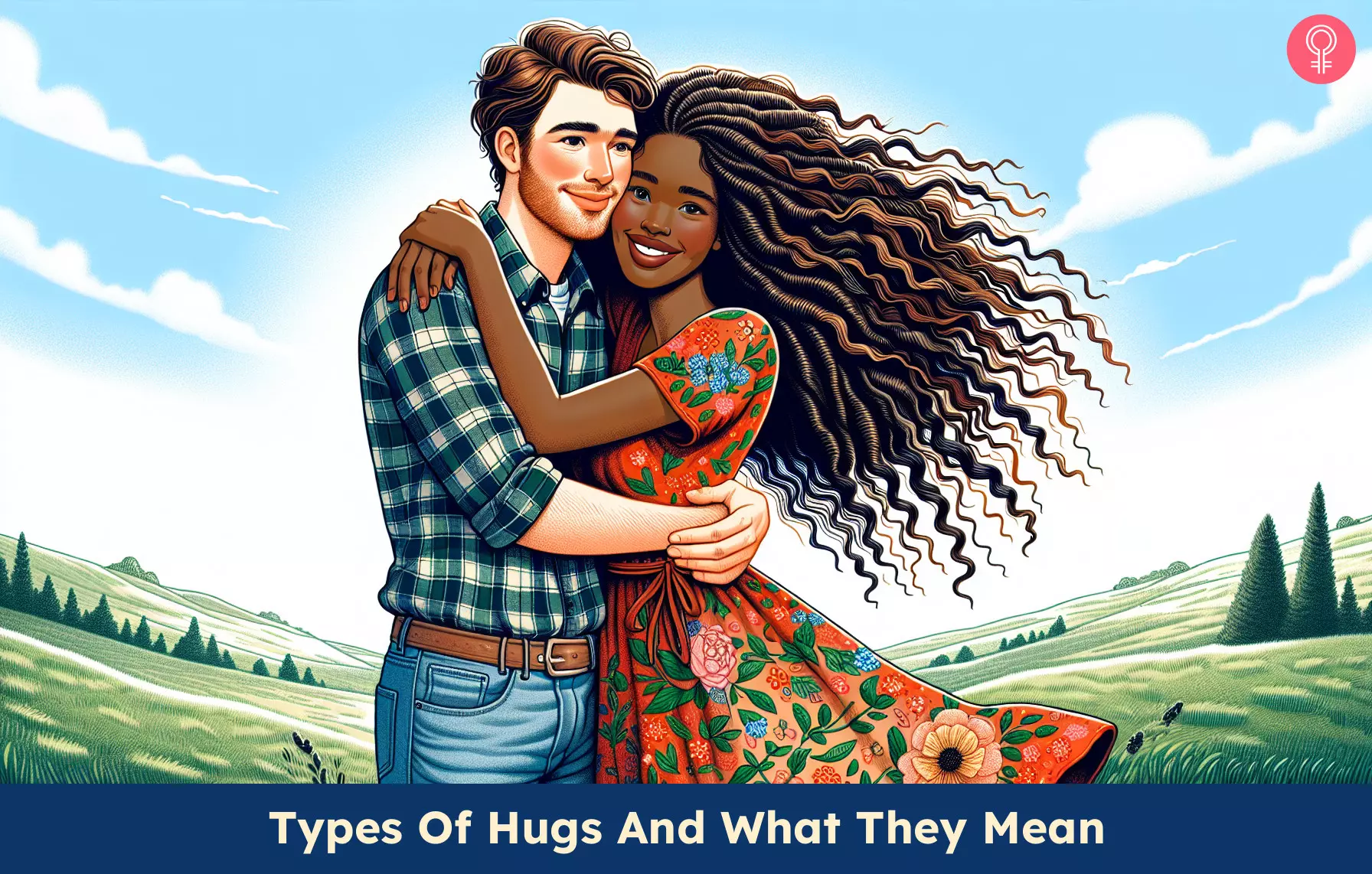Have you ever wondered why a hug feels so powerful? It’s more than just a physical gesture—it’s a universal language that transcends words. Whether it's a tight bear hug, a quick side hug, or even an awkward pat on the back, every type of hug carries its own meaning and emotion. But what exactly do these different hugs tell us about human connection? Let’s dive deep into this warm topic because understanding the meaning behind each embrace can change the way we communicate and bond with others.
Hugging is one of those things that everyone does but not everyone fully understands. It’s like breathing—we do it naturally without much thought. Yet, when you break it down, there’s so much depth to it. From platonic friendships to romantic relationships, every hug tells a story. And hey, who doesn’t love a good story, right?
This article isn’t just about hugging—it’s about decoding the unspoken messages behind them. So, whether you’re a hug enthusiast or someone who prefers their personal space, stick around because we’re about to explore the world of hugs like never before.
- Aaron Pierre Girlfriend The Ultimate Guide To His Love Life And Relationships
- Will Kevin Costner Be In Yellowstone The Ultimate Guide To The Iconic Actors Role
Here’s your roadmap to this heartwarming journey:
- Biography of Hugging
- Types of Hugs and Their Meanings
- Platonic Hugs
- Romantic Hugs
- Cultural Perspective on Hugs
- Psychological Benefits of Hugs
- Dealing with Awkward Hug Moments
- Hugs and Physical Health
- Hugs in Modern Times
- Conclusion: The Power of Hugs
Biography of Hugging
Before we get into the nitty-gritty of hug types, let’s talk about where hugging comes from. Believe it or not, hugging has been around for centuries—it’s basically ancient history wrapped in a warm blanket. Anthropologists believe that early humans used touch as a way to bond and show affection, and hugging evolved from there.
Hugging isn’t just for humans either. Animals like primates and even elephants have been observed engaging in similar behaviors to strengthen social ties. It’s like nature’s way of saying, "Hey, we’re all in this together." And honestly, isn’t that comforting?
- Cnn Anchor Quits On Air The Shocking Moment That Left Everyone Speechless
- Billie Eilish Images Your Ultimate Visual Guide
Fun Facts About Hugging
- Research shows that babies who receive regular physical affection grow up to be healthier emotionally and physically.
- Scientists claim that a 20-second hug can release oxytocin, often referred to as the "love hormone."
- Hugs can reduce stress levels by lowering cortisol, the stress hormone.
So yeah, hugging isn’t just cute—it’s scientifically awesome!
Types of Hugs and Their Meanings
Not all hugs are created equal. Some are tight, some are loose, and some are just plain weird. Here’s a breakdown of the most common types of hugs and what they mean:
The Bear Hug
Think of this as the ultimate full-body embrace. The bear hug is all-encompassing, squeezing you with love and care. It’s usually reserved for close friends or family members because it screams, "I’m so glad you’re here!"
Pro tip: If someone gives you a bear hug, know that they genuinely care about you. Don’t be shy—it’s okay to return the favor.
The Side Hug
Now here’s a fan favorite. The side hug is a quick, casual gesture often seen between friends. It’s like saying, "Hey, I see you, and I’m glad you’re around." Perfect for those moments when you don’t want to overstep boundaries but still want to show affection.
Fun fact: Side hugs are especially popular in professional settings where full-on bear hugs might feel a little too much.
Platonic Hugs
When it comes to friendships, hugs play a huge role in maintaining those connections. Platonic hugs come in all shapes and sizes, but they share one thing in common—they’re all about love and support without any romantic undertones.
For instance, a pat on the back might seem like a small gesture, but it carries a lot of weight. It says, "I’m here for you, no matter what." Meanwhile, a quick shoulder squeeze can convey empathy and understanding during tough times.
Variations of Platonic Hugs - Pat on the Back: Often used to congratulate someone or offer reassurance.
- Shoulder Squeeze: Perfect for showing support during emotional moments.
- High Five Followed by a Hug: A playful mix of celebration and affection.
Platonic hugs are all about balance. They create intimacy without crossing boundaries, making them ideal for long-lasting friendships.
Romantic Hugs
Ah, romance. There’s something magical about hugging the person you love. Romantic hugs are different from platonic ones because they carry an extra layer of passion and desire. They’re not just about comfort—they’re about connection.
Take the classic "movie hug," for example. You know the one where the couple embraces passionately after overcoming some obstacle. It’s cinematic gold because it encapsulates everything about love—trust, vulnerability, and devotion.
Key Moments for Romantic Hugs
- First Date: A gentle hug at the end of the night can leave a lasting impression.
- Reunion: After a long time apart, nothing says "I missed you" quite like a romantic hug.
- Apology: A heartfelt hug can mend fences and strengthen relationships.
Romantic hugs are all about timing and intention. They’re not just physical—they’re emotional.
Cultural Perspective on Hugs
Did you know that the meaning of hugs can vary depending on where you are in the world? In some cultures, hugging is a common greeting, while in others, it’s considered inappropriate. Understanding these differences is key to avoiding awkward situations.
For example, in Latin American countries, hugging is often seen as a sign of warmth and hospitality. On the other hand, in Japan, public displays of affection, including hugging, are generally frowned upon. It’s all about respecting cultural norms and boundaries.
Global Variations of Hugs
- France: A light kiss on the cheek is more common than a full hug.
- Brazil: Hugging and kissing on both cheeks are standard greetings.
- United States: Hugging is widely accepted, especially among friends and family.
So next time you find yourself in a new country, take a moment to observe how people interact. You’ll learn a lot about their culture through their physical gestures.
Psychological Benefits of Hugs
Hugging isn’t just a feel-good activity—it’s good for your mental health too. Studies have shown that regular hugging can reduce anxiety, improve mood, and even boost self-esteem. It’s like hitting the reset button for your brain.
When you hug someone, your body releases oxytocin, which promotes feelings of trust and bonding. At the same time, it reduces cortisol levels, helping you relax and unwind. No wonder hugs are often described as "natural therapy."
Tips for Using Hugs for Mental Health
- Make time for daily hugs with loved ones.
- Don’t underestimate the power of a self-hug—it works wonders!
- Encourage open communication about the importance of physical touch.
Remember, mental health matters, and hugging is just one way to nurture it.
Dealing with Awkward Hug Moments
We’ve all been there. You lean in for a hug, and the other person steps back. Or maybe you go in for a side hug, and they go for a full-on bear hug. Awkward moments happen, but the good news is they’re easy to handle.
The key is to laugh it off and keep things light. Nobody’s perfect, and sometimes miscommunication happens. Just smile, adjust, and move on. Chances are, the other person is just as embarrassed as you are.
Tips for Navigating Awkward Hugs
- Use humor to diffuse the situation.
- Pay attention to body language before initiating a hug.
- Respect personal boundaries and always ask for consent.
At the end of the day, it’s all about being considerate and understanding.
Hugs and Physical Health
Believe it or not, hugging can also benefit your physical health. It strengthens your immune system, lowers blood pressure, and even reduces pain. How’s that for a win-win?
Research conducted by Carnegie Mellon University found that people who received regular hugs were less likely to get sick during cold season. That’s right—hugging could be your secret weapon against sniffles.
Health Benefits of Hugging
- Boosts immune system function.
- Reduces risk of heart disease.
- Improves sleep quality.
So next time you feel a little under the weather, wrap yourself in a warm hug and see how much better you feel.
Hugs in Modern Times
In today’s fast-paced world, hugging has taken on new significance. With social media and digital communication dominating our lives, physical touch has become even more important. It’s a reminder that real connections still matter.
From virtual hugs during video calls to socially distanced fist bumps, we’re finding creative ways to maintain closeness without compromising safety. And let’s not forget the rise of "hug therapy" sessions, where people pay to receive professional hugs. Yeah, it’s a thing, and it’s surprisingly popular.
Modern Ways to Hug
- Virtual hugs through emojis and GIFs.
- Socially distanced alternatives like elbow bumps.
- Hug therapy sessions for emotional support.
As technology continues to evolve, so too will our methods of showing affection. But one thing remains constant—the power of a good hug.
Conclusion: The Power of Hugs
From bear hugs to side hugs, every embrace carries its own meaning and significance. Understanding the different types of hugs and their meanings can deepen our relationships and improve our overall well-being. Whether you’re hugging a loved one, a friend, or even yourself, remember that it’s more than just a physical act—it’s an emotional connection.
So go ahead, give someone a hug today. And if you’re feeling extra bold, share this article with your friends and family. Who knows? You might inspire a few more hugs in the process. After all, life’s too short not to spread a little love, right?
- The Riflemans Son A Journey Through Legacy History And Impact
- Unveiling The Power Of Led Zeppelins Lead Guitar Magic


